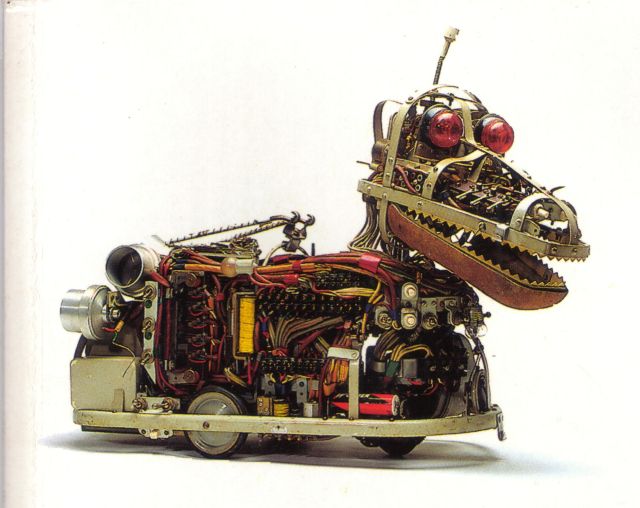
From Daniel C. Dennett's Home Page http://ase.tufts.edu/cogstud/incbios/dennettd/dennettd.htm [Mar08]
REWARD for information! I found it in an antique shop in Paris. It was made in France in the 1950s, so I have named it Tati, in honor of Jacques Tati (whose classic film Mon Oncle captures the same era with the same ingenious and humorous use of technology). I do not know who made Tati, or why, and would be pleased to receive any substantiated information about its provenance.
Further information was received on 12 March 2008 by email –
One correspondent has told me that Tati (my name for it, of course, not the name its creator chose, certainly) was commissioned by Prince Louis de Broglie, the Belgian physicist and Nobel laureate, for his granddaughter in Paris. She fell on hard times and sold it to an antique dealer. Could be, but my efforts to confirm the story have not yet born fruit.
Best wishes,
Daniel Dennett
[Ed. – Louis de Broglie was actually French and a bachelor.]

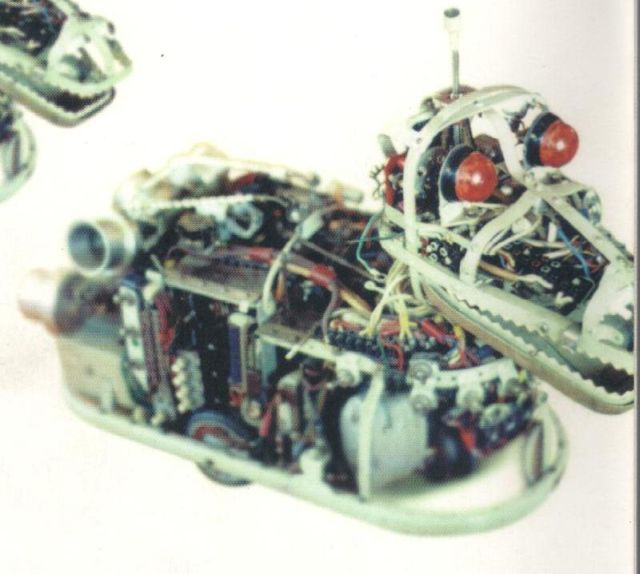
Image of "Tati" reversed on actual cover of book.
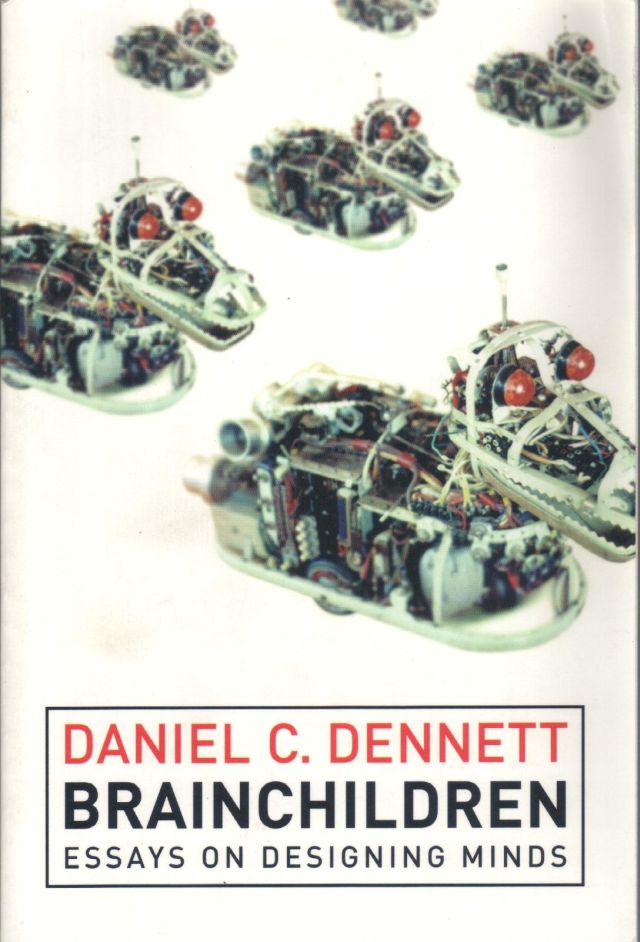
Tati on the cover of Dan Dennett's book Brianchildren Essays on Designing Minds.

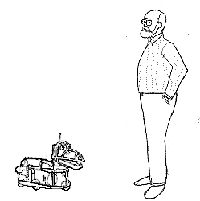
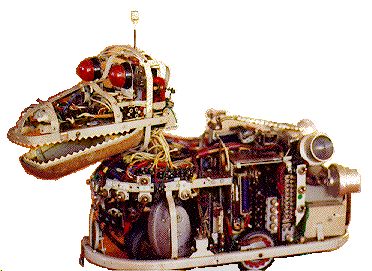

The spring head antenna is most likely an overhead collision or bump detector. There are 4 sets of contacts inside the head, surrounding a dark red, brownish ball mounted on the lower end of the spring. A possibility could also be that it is used for manual steering/guidance, much like a joystick.

I'm unsure what the 3 sets of contacts mounted in the nose perform. Each of the lower contacts has a fine, element type wire wound around it. To the left, as seen in the previous image, is a cooling fan (and not the motor used for eye or jaw movement). These contacts may be a type of thermostat.
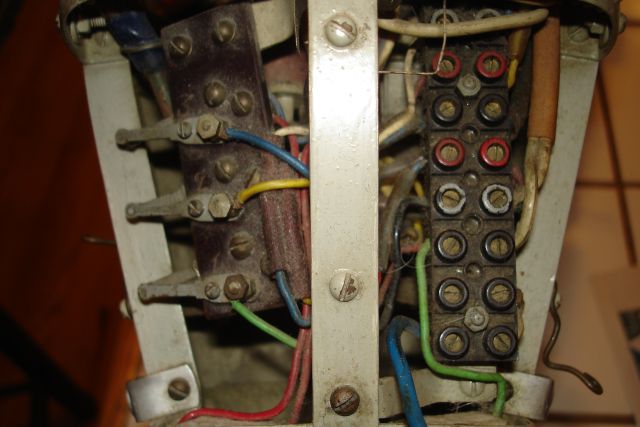

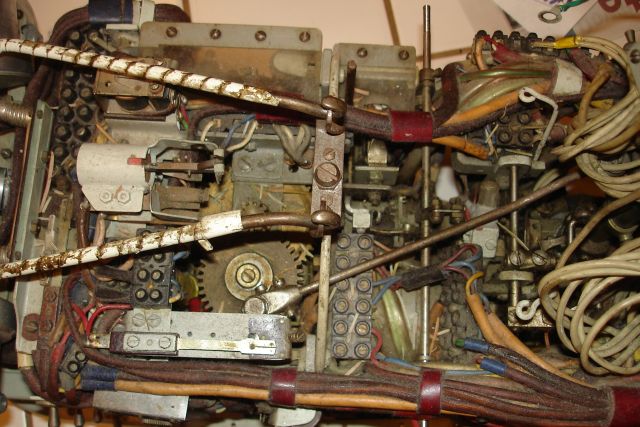
The driven gear wheel with attached crank arm steers the head. The head is unable to fully rotate; my guess is that it can only rotate about 30 deg. left or right, which also gives clues as to how it needs to be steered for overall guidance.

The aluminium 'cups' are Selenium cells – you can see metallic strips (3 strips) [ also seen in IOTA (4 strips)], but are mounted at the rear.
Unlike IOTA, where the selenium cells are used as 'eyes' for photo-tropism, they appear to be positioned more for remote-control purposes. So rather than be led by a light beam, it is possibly controlled by a light beam from behind. There are 5 separate cells at the rear (tati06.jpg – above); 2 located at each rear corner facing directly behind ; 2 at 90 deg to those just mentioned for side control; and 1 single cell directed rearwards mounted mid-point on the rear of the dog's body.
Possibilities on how these operated:
Factors to consider: steering is limited in the amount of head turn (see other photos for later discussion). This being the case, a reversing mechanism is probably required for the dog. What triggers the reversing mechanism? The central selenium cell?
- rear central facing rearward – for stopping / starting dog, or using negative tropisms e.g. when illuminated from the rear, drive ahead – steering straight. More likely it triggers the dog to reverse its drive motor. (Note: The steering wheel is also the driving wheel. The side wheels are unpowered).
- rear-left – facing rearward – function unknown?
- rear-left – facing left – forces steering to the left?
- rear – right – facing rearward – function unknown?
- rear – right – facing right – forces steering to the right?
The brand of the battery is “Wonder”. It is an old French firm. This firm was sold to the American company Ralston (Energizer) in 1988. Certainly that little battery does not power the motors. There are no images of the rear of the robot dog, but I suspect that is where the heavier, larger batteries reside.
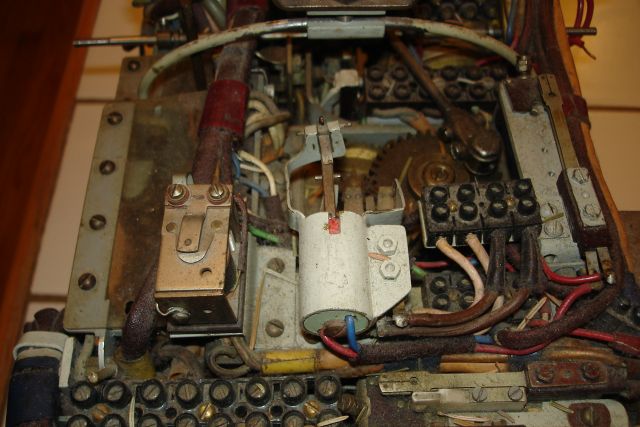
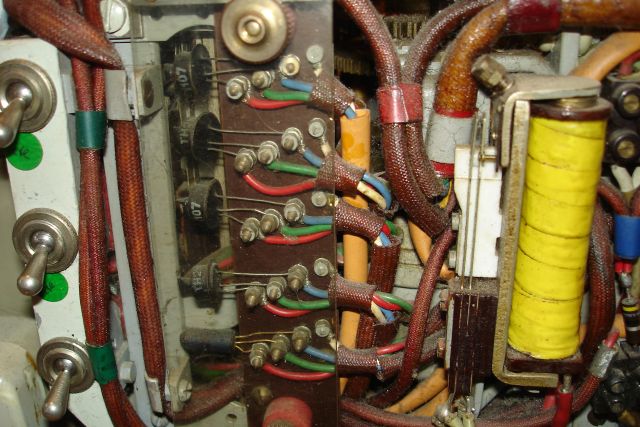
The GE 2N107 transistor was introduced into the market in 1955. See the Semiconductor Museum here.
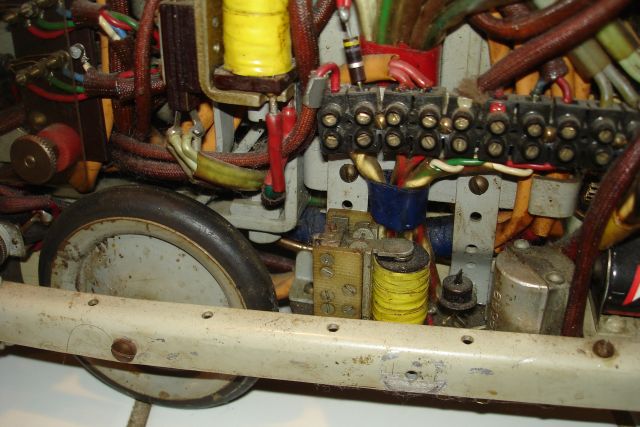

Close-up of one of the Selenium cells.
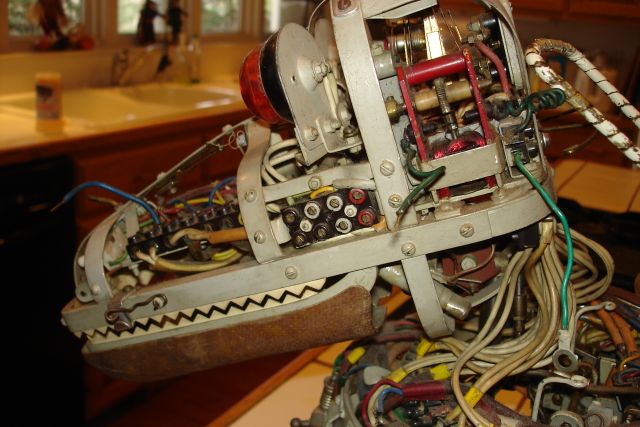
The red motor in the back of the head drives a worm gear which in turn connects to the red eyes to swivel them left or right.

The motor is from the S.E.V company (Société Anonyme pour L’Équipment Électrique des Véhicules) that manufactured pre-war car components. It is a wiper motor, one of the few that could operate in manual or automatic mode at that time. [Nico-Aug 2011]
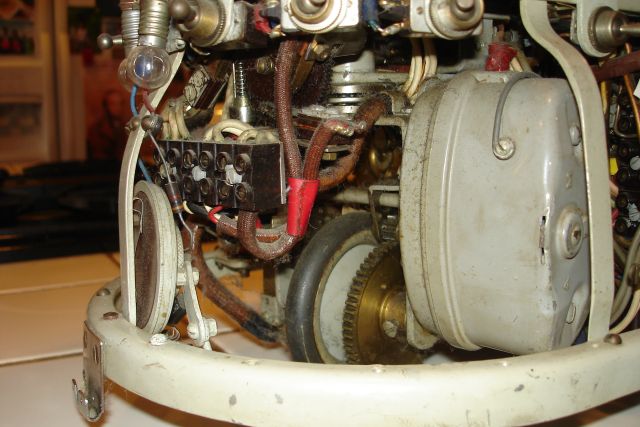
You can just see the vertical worm drive. This may be the motor and drive system that tilts the head.
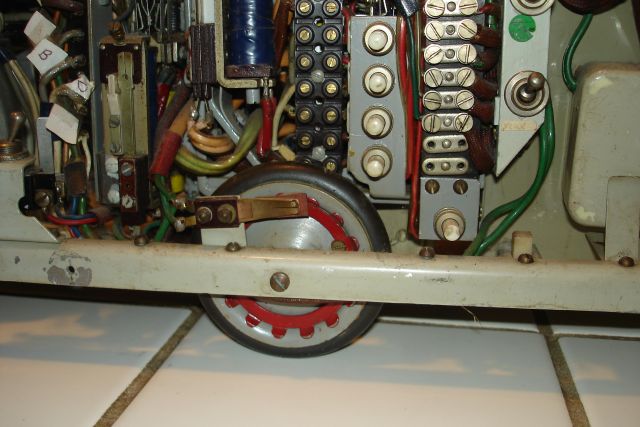
Crude form of distance counter incorporated in the wheel. As the red tangs pass under the contacts, a circuit is opened and closed.
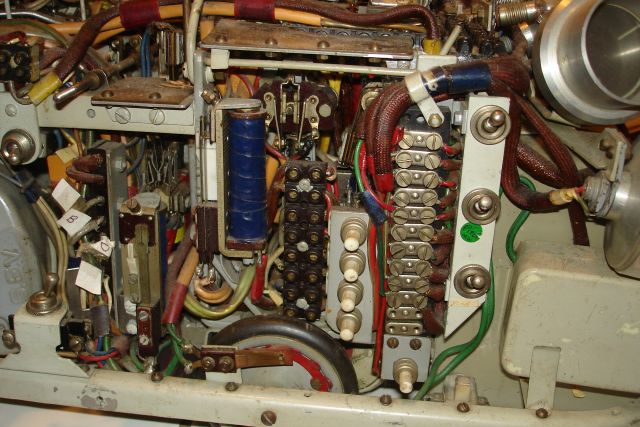
To the right of the blue-taped relay coil is an oval spindle (a cam). As it rotates it opens a pair of contacts mounted on each side of the cam. Function currently unknown.

The white-taped rod is the carrying handle. The diagonal rod operates the steering. Another bent rod at the base of the head lifts or lowers the head. There is a rod, threaded both end, that travels from the left to the right of the body. There is a crank and rod in the middle, but its function is currently unknown.
Hi Johnny, A grad student working with Dennett is investigating Tati’s origins. Hopefully we’ll all get an update soon.
Reuben.
(cyberneticzoo.com)
Apologies- just read through the authors descriptions and realised this had already been said!
Hello All,
Is it possible the Selenium cell’s were used as some form of remote control in conjunction with a flashlight?
My thinking is that by default the robot would drive forward and those operating / playing with it could initiate a turn by shining a light upon them.
Fascinating piece of kit- I wish we could see some videos of a restoration / investigation.
Regards,
Johnny
Hi Gary, Thanks for your comments. As there are 3 bimetal over-current trips, one is guessing as to what they’re used for. Maybe they are wired in series to effect a staged timer? Other models in my Cybernetic Creature list use a load-sensing technique (instead of a bump-sensor) to detect an obstacle or unclimbable incline. One examply is a coil of wire around a reed-switch, but one of the thermostats in Tati could be used for that purpose. Most cybernetic models of this era modelled “conditional reflexes”. I’ve seen memistors used, but again Tati’s thermostats could achieve the same effect.
The main battery is probably a large wet-cell (small car or motorcycle type) mounted between the 2 smaller grey boxes you mention. Another photo from Dan would confirm. Are you using the larger hi-res images of Tati (2592×1728 ~ 2mb) to view the detail? – Regards, Reuben.
Hello.
The contacts in the nose area are bimetals and the device is commonly used as either an over-current trip (too much current heats the strip until it opens), a flasher circuit (current heats strip, circuit opens, current stops, strip cools and closes contact), or as a timer (current slowly heats strip until it opens or closes contact). The fan looks too far away to have much effect but might have been intended to slow the heating/quicken the cooling effect. Incidentally, these things consume quite a bit of juice.
Batteries: there are two grey tins at the rear that may have held batteries. They can be seen in some of the photographs.
The thing that’s got my curiosity is the fine wire (spring/lever) gadget with a curl in it running near the contacts under the bridge of the dog’s nose. I wonder what it does?
Photocells: putting them on the rear maybe gives some control as he’s running away from you. If the dog’s coming towards you, it could just be grabbed hold of. Running away is more of a problem.
hope this is of some use,
Gary